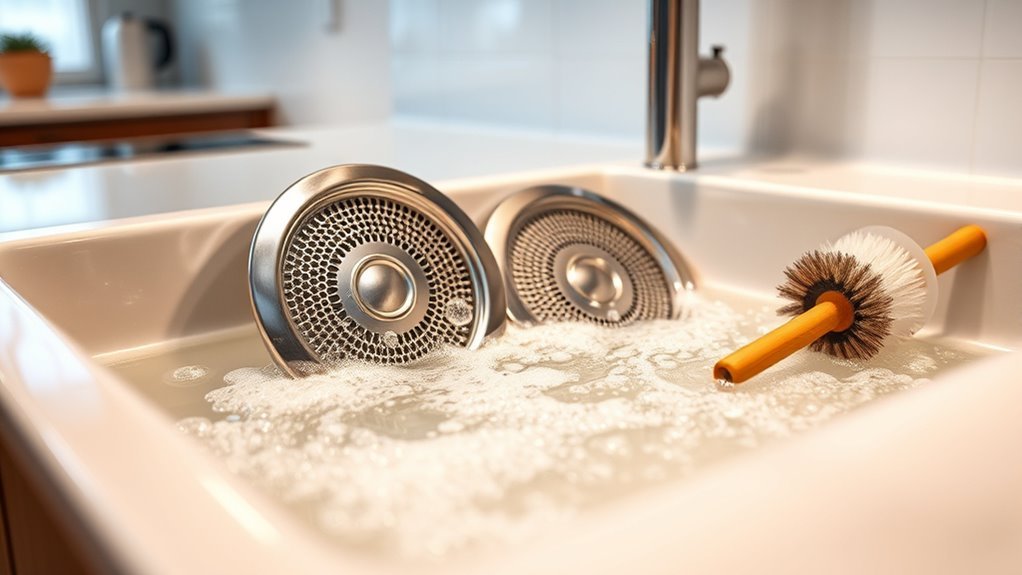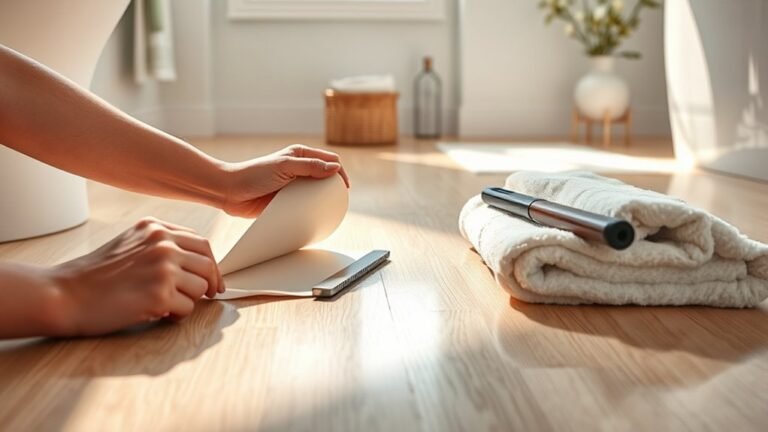Weekly Cleaning Routine for Range Hood
To keep your range hood efficient, turn it off and cool before you start. Remove and soak the filters in hot water with dish soap and vinegar for 15–20 minutes to loosen grease. Gently scrub, rinse, and let them dry completely before placing them back. Wipe the exterior with a gentle cleaner to prevent buildup. Doing this weekly stops odors and maintains performance. Keep following for a complete guide to guarantee your hood runs smoothly and lasts longer.
Preparing Your Range Hood for Cleaning

Before you begin cleaning your range hood, make certain it’s completely turned off and cool to the touch. This simple step guarantees your safety and prevents any accidental damage. Next, focus on filter maintenance—removing the filters carefully so you can tackle grease buildup effectively. Filters trap a lot of grime, and letting grease accumulate reduces your hood’s efficiency and can even cause unpleasant odors. Once you remove them, you’re free to soak and scrub the filters thoroughly, restoring their performance. Preparing your range hood this way isn’t just about cleanliness—it’s about reclaiming control over your kitchen environment. By handling filter maintenance regularly, you avoid stubborn grease buildup, making your weekly cleaning quicker and your range hood more reliable.
Cleaning the Exterior Surfaces
Several key areas on your range hood’s exterior need regular attention to keep it looking fresh and functioning well. Start by identifying the exterior materials—whether stainless steel, glass, or painted surfaces—since each demands specific care. Use a gentle, non-abrasive cleaner suited for those materials to avoid damage. Wiping down with a soft cloth prevents scratches and maintains surface protection, extending your hood’s lifespan. Don’t forget to clean the control panel and edges where grease tends to accumulate. Regularly removing buildup not only preserves appearance but also keeps your kitchen environment healthier. By treating the exterior surfaces with care and consistency, you maintain both the freedom to cook without worries and the pride of a well-kept kitchen centerpiece.
Removing and Soaking the Filters

Start by carefully removing the filters from your range hood, as this step is essential for effective cleaning. Depending on your model, you might have mesh, baffle, or charcoal filter types, each requiring gentle handling to prevent damage. Once removed, choose the right soaking solution to break down grease and grime effortlessly. A mixture of hot water, dish soap, and a splash of vinegar works well for most filters, while charcoal filters might need a different approach, often replacement rather than soaking. Let the filters soak for at least 15-20 minutes, allowing the solution to loosen stubborn residues and make your next cleaning step easier. This simple act of soaking liberates your filters, helping you maintain a fresh, efficient range hood without hassle.
Scrubbing and Drying the Filters
Once your filters have soaked long enough to loosen grease and grime, it’s time to scrub them gently but thoroughly. Proper filter maintenance guarantees your range hood operates freely and efficiently. Use a soft brush with your chosen degreasing solutions to avoid damaging the mesh.
Follow these steps to scrub and dry your filters:
- Gently scrub both sides, focusing on greasy spots.
- Rinse under warm running water to wash away residue.
- Shake off excess water to speed drying.
- Lay filters flat or hang them in a well-ventilated area to dry completely.
Taking these simple actions liberates your cooking space from buildup, keeping your range hood fresh and functional week after week.
Reassembling and Final Touches

After your filters are completely dry, you can reassemble your range hood to restore its full function. Start by carefully placing each filter back into its slot, ensuring they fit snugly. This step is essential for effective filter maintenance and keeping your kitchen air fresh. Next, wipe down the exterior and any accessible interior surfaces using your preferred cleaning supplies to remove any remaining grease or dust. Don’t forget to check the fan blades and light covers for buildup. Once reassembled, test the range hood to make sure everything runs smoothly. By dedicating a few minutes weekly to these final touches, you’re not only prolonging your range hood’s life but also securing the freedom to cook without worry or lingering odors.
Frequently Asked Questions
How Often Should I Replace My Range Hood Filters Entirely?
You should consider your filter replacement frequency based on the type of filter material options your range hood uses. Metal mesh filters can last longer with regular cleaning, so you might replace them every 6 to 12 months. Charcoal or carbon filters, however, need replacing more often, usually every 3 to 6 months. Trust your lifestyle and cooking habits to guide you—freedom means adapting your routine to what feels right for you.
Can I Use a Dishwasher to Clean Range Hood Filters?
You can use a dishwasher to clean range hood filters, but you need to check dishwasher safety first. Many metal filters are dishwasher safe, making filter cleaning easier and freeing up your time. Just avoid harsh detergents or high heat settings to prevent damage. If your filters aren’t dishwasher safe, stick to soaking them in hot, soapy water. This way, you keep your filters clean without restricting your cleaning freedom.
What Type of Cleaning Products Are Safest for Stainless Steel Hoods?
Did you know 85% of stainless steel surfaces get damaged by harsh chemicals? When cleaning your stainless steel hood, you’ll want to avoid that by choosing safe options. Natural cleaners like vinegar and baking soda work wonders without harming the finish. If you prefer commercial solutions, pick ones labeled as stainless steel safe and non-abrasive. This way, you get a spotless hood and keep your freedom to cook without worry.
How Do I Prevent Grease Buildup on My Range Hood?
To prevent grease buildup on your range hood, focus on grease prevention through mindful cooking habits. Make sure you turn on the hood every time you cook, especially when frying or using oil. Keep your stovetop clean to reduce airborne grease particles. Also, avoid cooking at excessively high temperatures, which can increase grease splatter. By staying consistent with these habits, you’ll enjoy a cleaner range hood and more freedom from tough, greasy messes.
Are There Any Maintenance Tips for the Range Hood Motor?
Think of your range hood motor as the heart of your kitchen’s breath—it needs care to keep motor efficiency high. You should check and clean the motor regularly to prevent dust buildup, which can slow it down. Using proper lubrication techniques on the motor’s moving parts is key to avoid friction and wear. Don’t forget to tighten any loose screws and guarantee the fan blades spin freely. This way, you’ll keep your kitchen air fresh and your motor running smooth.






